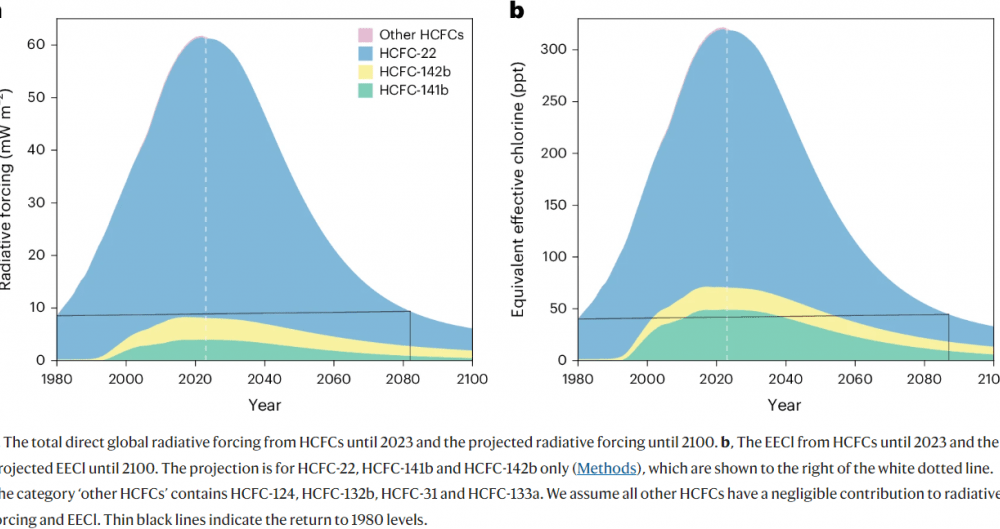HCFC emissions peak in 2021, ahead of projections; Paper highlights success of Montreal Protocol in mitigating climate change
In a promising development for the environment, a new study released June 11, 2024 has reported the first significant decrease in atmospheric concentrations of potent ozone-depleting substances (ODS) known as hydrochlorofluorocarbons (HCFCs). This reduction has occurred five years before the target year, signifying a crucial step forward in efforts to mend the ozone layer.
HCFC emissions peaked in 2021, five years sooner than the anticipated year 2026 and are heading in the right direction, the research published in journal Nature Climate Change said.
The paper by lead author Luke Western and his colleagues at the University of Bristol found that reducing HCFCs, which are harmful greenhouse gases, could help mitigate climate change.
Read more: Immense potential for greener HFC alternatives in India
The authors showed that the impact of HCFCs on the Earth’s energy balance (known as radiative forcing) and the amount of chlorine from these gases in the atmosphere (called equivalent effective chlorine) have decreased since 2021 five years earlier than expected.
HCFCs trap heat in the Earth’s atmosphere and have an impact on climate and radiative forcing. A drop in levels leads to a smaller impact on the warming of the planet.
Equivalent effective chlorine refers to the globally averaged chlorine content of ODS in the troposphere.
The study discovered that in 2022 and 2023, both the equivalent effective chlorine and the global direct radiative forcing from HCFCs decreased.
The total radiative forcing and EECl from HCFCs

Source: A decrease in radiative forcing and equivalent effective chlorine from hydrochlorofluorocarbons
In 2023, the global direct radiative forcing from HCFCs decreased to 61.28 milliWatt per square metre (mW m−2), down from 61.67 mW m−2 in 2022. In 2023, the equivalent effective chlorine (EECl) of HCFCs decreased to 319.33 one part per trillion (ppt) from 321.35 ppt in 2022.
As per the paper, the fall was most rapid in the northern hemisphere, reflecting emission changes. The Northern hemisphere includes India, which is ahead of eliminating HCFCs in new equipment manufacturing, claimed the government in a report released during 28th Conference of Parties (COP28) to the United Nations Framework Convention on Climate Change held in Dubai, United Arab Emirates in December 2023.
Drop in HCFC-22, the most abundant HCFC
HCFC-22, the most abundant HCFC, has witnessed the most significant decline. HCFC-22, has a global warming potential 1,910 times that of carbon dioxide on a 100 year time horizon.
The drop in radiative forcing and EECl was mainly due to the decline of HCFC-22 between 2021 and 2023.
Read more: A monopoly like none other
A minor decline was also observed in HCFC-141b, the second most prevalent, from 24.63 ppt in 2022 to 24.51 ppt in 2023. Since 2017, the third most prevalent, HCFC-142b, has been progressively declining.
HCFC-22 is used as a refrigerant in a variety of applications, including unitary air conditioners, cold storage, retail food refrigeration, chillers, and industrial process refrigeration.
Montreal Protocol contributions to decline in HCFC levels
“This important milestone demonstrates the benefits of the [Montreal] Protocol for mitigating climate change and stratospheric ozone layer loss,” read the paper.
The Montreal Protocol, signed in 1987, is a global agreement to protect the stratospheric ozone layer by eliminating the production and consumption of ODSs like chlorofluorocarbons (CFCs). The worldwide production of CFCs has been prohibited since 2010.
In order to replace CFCs, HCFCs were produced. However, they are also strong greenhouse gases and ODSs. Therefore, the Copenhagen (1992) and Beijing (1999) Amendments to the Montreal Protocol mandated the phase-out of HCFC production and usage.
Since then, hydrofluorocarbons (HFC) have become available as a substitute for HCFCs. The production of HCFCs is currently being phased out globally, with a completion date slated for 2040.
The research paper acknowledges and endorses the role of global agreements, such as the Montreal Protocol, in curbing HCFC emissions.
“By enforcing strict controls and promoting the adoption of ozone-friendly alternatives, the protocol has successfully curbed the release and levels of HCFCs into the atmosphere,” said Western in a statement. The lead author is Marie Curie Research Fellow, School of Chemistry, University of Bristol.
“Without the Montreal Protocol, this success would not have been possible, so it’s a resounding endorsement of multilateral commitments to combat stratospheric ozone depletion, with additional benefits in tackling human-induced climate change,” the statement added.
The HCFCs will return to their 1980 values in 2082 for radiative forcing and in 2087 for the EECI, projected the research.
As strong greenhouse gases, these HCFCs should also contribute to lessening global warming if they are reduced, the paper said.
Read more: Climate of irrationality
HFCs have largely replaced HCFCs for many purposes and restrictions on their manufacture and consumption were introduced by the Kigali Amendment in 2016 to the Montreal Protocol.
The Kigali Amendment imposed strict restrictions on the production and use of HFCs, which are increasingly used as replacements for HCFCs in a variety of applications.
Additionally, pledges to cut HFC emissions have been made as part of the Global Cooling Pledge and the Paris Agreement. Nevertheless, the radiative force brought on by HFCs is still rising in spite of the controls.
However, as was noted for HCFCs, strict adherence to these global agreements could reduce the radiative impact of HFCs too, said the research.
We are a voice to you; you have been a support to us. Together we build journalism that is independent, credible and fearless. You can further help us by making a donation. This will mean a lot for our ability to bring you news, perspectives and analysis from the ground so that we can make change together.












































